Related Research Articles

Ripley County is a county in the Ozarks of Missouri. At the 2020 census, it had a population of 10,679. The largest city and county seat is Doniphan. The county was officially organized on January 5, 1833, and is named after Brigadier General Eleazer Wheelock Ripley, a soldier who served with distinction in the War of 1812.

Doniphan County is a county located in the U.S. state of Kansas. As of the 2020 census, the county population was 7,510. Its county seat is Troy, and its most populous city is Wathena.

Crossett is the largest city in Ashley County, Arkansas, United States, with a population of 5,507, according to 2010 Census Bureau estimates. Combined with North Crossett and West Crossett, the population is 10,752. Crossett was incorporated in 1903.
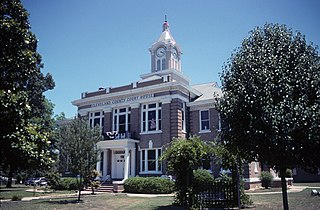
Rison is a city in and the county seat of Cleveland County, Arkansas, United States. Its population was 1,344 at the 2010 U.S. census. It is included in the Pine Bluff, Arkansas Metropolitan Statistical Area. Rison is a bedroom community for people who work in Pine Bluff. The largest employers are the city and county governments, the Cleveland County School District, the Cleveland County Nursing Home. There are two banks, eight churches, and about forty-five businesses within the city limits. Among the local properties listed on the National Register of Historic Places are the Rison Cities Service Station and the Rison Texaco Service Station.
PotlatchDeltic Corporation is an American diversified forest products company based in Spokane, Washington.
Bucksville is a small unincorporated community in Horry County, South Carolina, United States. It lies near Bucksport on the Pee Dee River and Waccamaw River. Two properties are listed on the National Register of Historic Places: the Buck's Upper Mill Farm and Hebron Church.

The Marine Mill, established in 1839, was the first commercial sawmill in what became the U.S. state of Minnesota. Now in ruins, it is currently a historic site managed by the city of Marine on St. Croix in partnership with the Minnesota Historical Society. It was listed on the National Register of Historic Places as the Marine Mill Site in 1970 for having state-level significance in the themes of exploration/settlement, industry, and transportation. It was nominated for being the birthplace of the region's seminal industry—lumbering—and a major landing on its crucial transportation route, the St. Croix River. The site is also a contributing property to the Marine on St. Croix Historic District.

This is a list of the National Register of Historic Places listings in Doniphan County, Kansas.

This is a list of the National Register of Historic Places listings in White County, Arkansas.
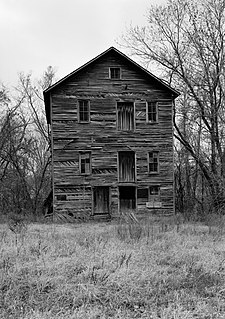
The Hildebrand Mill on Flint Creek in Colcord, Delaware County, Oklahoma was built c. 1845 and served hill people of the Old Cherokee Nation territory for more than 125 years. It is located not far from Siloam Springs, Arkansas. It was listed on the National Register of Historic Places in 1972.
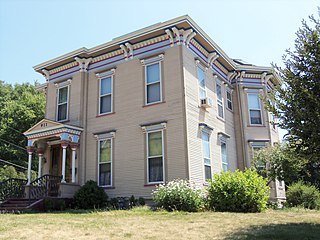
The James E. Lindsay House is a historic building located on the east side of Davenport, Iowa, United States. It has been listed on the National Register of Historic Places since 1984.
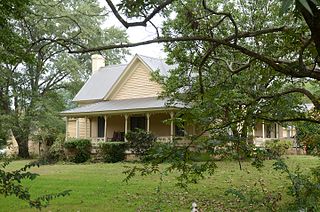
The Womack–Parker House is a historic house off Arkansas Highway 4 in Nashville, Arkansas. The house is notable for its age, its association with one of Nashville's leading businessmen, and for its distinctive architecture. The house is a single block of wood-frame construction with a central hall plan. It has porches with decorative jigsaw woodwork on three sides. Its construction date is uncertain, but it was purchased in 1878 by David Womack and extensively altered. Womack arrived in Howard County in 1849, and operated a highly successful array of businesses, including a lumber mill, and a cotton gin. The property on which the house stands also includes a variety of 19th-century log structures.

The Three States Lumber Company Mill Powerhouse, also known as the Burdette Plantation Company Store, is a historic industrial site on Old Mill Road in Burdette, Arkansas. The only surviving element of what was once a much larger sawmill, the powerhouse is a two-part structure built in 1909 to provide electrical power to the Three States Lumber Company. The northern part of the building is a two-story brick structure with a gable roof, while the southern part is a single-story shed-roof concrete structure, which includes the remnants of a smokestack. The Three States company ran a large sawmill on this site between 1906 and 1922, removing most of the structures when its operations shut down. The property was converted into a plantation when the company moved out, and this building became the company store.
The C.A. Stuck and Sons Lumber Mill is a historic industrial complex at 215 Union Street in Jonesboro, Arkansas. It consists of four buildings: an office building, a lumber mill, and two storage sheds. All four buildings are brick structures built c. 1890, although the office building was enlarged and given a new facade in 1905. The Stuck mill, which was established in 1889, is one of the oldest properties associated with the early efforts to deforest Craighead County. C.A. Stuck was an Illinois-based furniture builder who moved to Jonesboro to facilitate the production of lumber for his products.

Van Winkle's Mill Site is a historic 19th-century industrial site at 21392 Arkansas Highway 12 near Rogers, Arkansas. The area, located in the hollow of Little Clifty Creek northeast of the junction of AR 12 with AR 127, includes the foundational remnants of a series of mills operated between 1850 and 1890 by Peter Van Winkle, a major figure in the lumber industry of northwestern Arkansas in the late 19th century. The site included, in addition to mill buildings, Van Winkle's residence, a blacksmithy, and quarters used by the workers, which included slaves during the period before the American Civil War. Oral histories pertaining to the site include claims of a cemetery, but excavations conducted between 1997 and 2005 failed to produce evidence of its location. Van Winkle's first mill and house were burned during the Civil War, and the site was later scavenged for materials after it was abandoned.

The Orth C. Galloway House is a historic house at 504 Park Street in Clarendon, Arkansas. It is a 2+1⁄2-story wood-frame structure, with Colonial Revival styling designed by George Franklin Barber. It was built in 1910 for Orth Galloway, owner of a local lumber mill. Barber's design is of a considerably higher style than was typically found in his pattern-book publications, which were widely used in the southern US. Its most prominent feature is its two-story Classical Revival entrance portico, supported by clustered Doric columns.

The Mechanicsville Historic District encompasses a cluster of residential properties that are all that remain of one of the early industrial areas of Grafton, Vermont. Located a short way east of Grafton Village on Vermont Route 121, it includes ten well-preserved 19th-century properties, some located on properties where early mills once stood. The district was listed on the National Register of Historic Places in 2010.
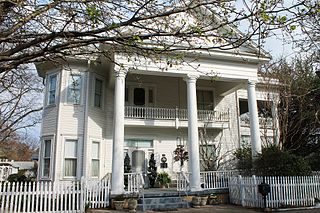
The Marcus DeWitt Carlock House is a house with Neoclassical and late-Victorian architectural characteristics that is listed on the National Register of Historic Places and as a Recorded Texas Historic Landmark located at 407 South Main Street, approximately three blocks south of downtown, in Winnsboro, Wood County, Texas. It was the first National Register of Historic Places listing in the city of Winnsboro.

Highway 36 is a state highway in Central Arkansas. The highway begins at U.S. Highway 64 (US 64) at Hamlet and runs east through several small communities to Searcy, where it serves as the Beebe-Capps Expressway, a major crosstown arterial roadway. Following a discontinuity at US 64/US 67/US 167, the highway continues east to Kensett as Wilbur D. Mills Avenue before state maintenance ends at the small community of Georgetown. This highway is maintained by the Arkansas Department of Transportation (ARDOT).

The Missouri Lumber and Mining Company (MLM) was a large timber corporation with headquarters and primary operations in southeast Missouri. The company was formed by Pennsylvania lumbermen who were eager to exploit the untapped timber resources of the Missouri Ozarks to supply lumber, primarily used in construction, to meet the demand of U.S. westward expansion. Its primary operations were centered in Grandin, a company town it built starting c. 1888. The lumber mill there grew to be the largest in the country at the turn of the century and Grandin's population peaked around 2,500 to 3,000. As the timber resources were exhausted, the company had to abandon Grandin around 1910. It continued timber harvesting in other parts of Missouri for another decade. While some of the buildings in Grandin were relocated, many of the remaining buildings were listed on the National Register of Historic Places in 1980 as part of the state's historic preservation plan which considered the MLM a significant technological and economic contributor to Missouri.
References
- 1 2 "National Register Information System – (#91001196)". National Register of Historic Places . National Park Service. July 9, 2010.
- ↑ "NRHP nomination for Doniphan Lumber Mill Historic District". Arkansas Preservation. Retrieved 2015-09-01.